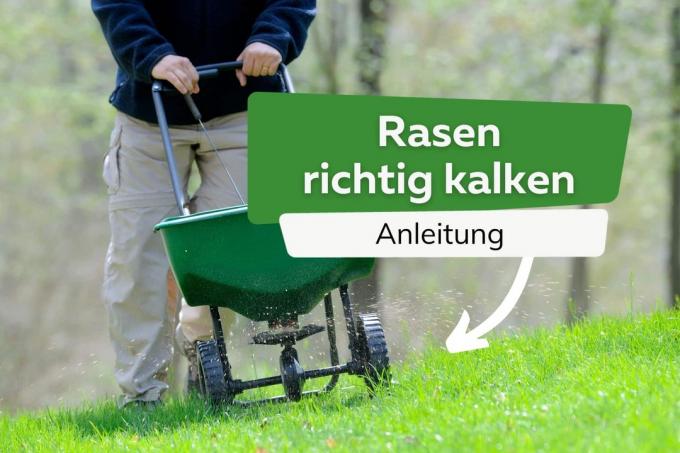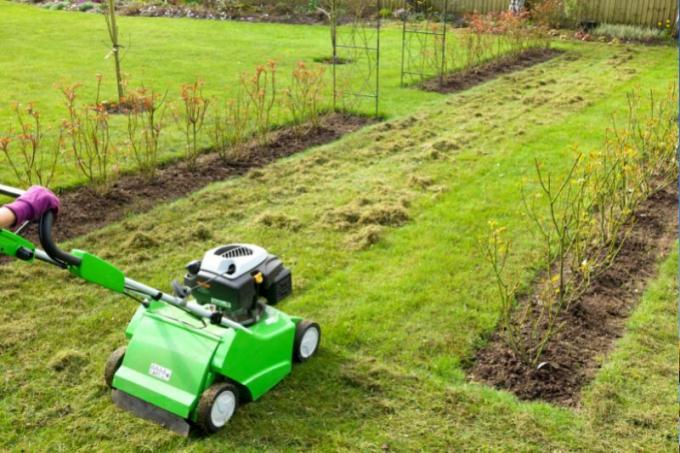
Lime is an important source of minerals for the lawn so that it can develop optimally and problems can be prevented. Lime affects soil pH, so dosage is important.
In a nutshell
- lime in spring
- wait for dry and windless weather
- scarify the ground
- Apply lime evenly
- water after liming
Table of contents
- choose time
- Prepare lawn
- select dosage
- apply lime
- Follow-up care of the area
- frequently asked Questions
choose time
From spring to autumn it is possible to whitewash the lawn. The best time is spring. You can lime as part of the spring care complete. The lawn gets new energy and the weather is usually better than at other times of the year.
In addition, the lawn needs some rest after liming. You shouldn't enter it for a few weeks. This means that the lawn area can be used without any problems during the main season.

Tip: Especially after a cold and dry winter, the lawn needs a good start in spring. In extreme weather conditions, you can quickly restore the grass to a lush green color by liming it.
When liming, also make sure that the weather is suitable. This makes application easier and the lawn can quickly absorb the lime.
Suitable weather conditions:
- dry
- windless
- covered
Prepare lawn
You should prepare the surface so that the lime can go directly into the soil. With this you already take care of a large part of the seasonal care of the lawn.
Preparatory work:
- scarify
- even out uneven spots
- sand
- reseed bare spots

select dosage
How much lime You use depends on the soil conditions. Basically, the heavier the soil, the greater the need for lime.
Guide values for the amount of lime:
- heavy soil (loam and clay): 250-400 g/m²
- medium-heavy soil (clay and sand): 180-400 g/m²
- light soil (sand): 120-180 g/m²

Notice: Pay attention to the dosage information for mixed products from the trade. Quantities may vary due to other ingredients.
apply lime
It is optimal if you remove the lime with a spreader bring out This makes it possible to supply the surface evenly with lime. Manual application is also possible. Regardless of whether you spread the lime with a spreader or by hand, you should always take a few safety precautions beforehand. If limescale gets on your skin or in your eyes, it can have serious health consequences.
Safety measures:
- wear gloves
- cover arms and legs
- Possibly. wear safety glasses
When applying, make sure that it is not raining and there is no wind. When it is windy, fine lime dust can get into your eyes and cause chemical burns.
Follow-up care of the area
Although it should be dry for liming, you need the area water after liming. Make sure that the drying phase is longer, because watering will make the lime available to the grass more evenly. Persistent rainy weather would ensure that the lime is dissolved too quickly and seeps into deeper layers with the water.
Try not to walk on the whitewashed area for about four weeks. As a result, the soil is not immediately compacted again and the lime can reach the roots better.

Four weeks after liming is also the right time to fertilize the lawn for the first time. This gives reseeding the opportunity to grow well. In addition, a large part of the lime is dissolved and has been absorbed by the grass. The turf then needs nutrients so that it can grow in length.
frequently asked Questions
There is suitable lime for lawns on the market. This can be found, for example, under the name "lawn lime". Alternatively, you can also use commercially available garden lime. This is a bit coarser and takes longer to loosen. For example, slaked lime or other types of lime that are offered as building materials are not suitable.
Lime always affects soil pH. You should therefore determine the pH value before liming, as this can influence the dosage. When liming as part of the annual lawn care, you should ensure a pH value of 5.5 to 6.5. The heavier the soil, the higher the pH should be.
With a normal pH value, it is sufficient if you whitewash the surface once a year. If there is a severe undersupply of lime, you may have to apply lime several times a year in order to achieve the optimum pH value. Sandy and well-drained soils in particular are at risk of the pH value quickly falling below the optimum.

